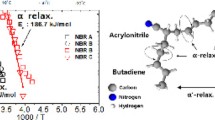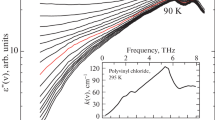Abstract
A model is proposed which explains the shape of the dielectric relaxation function at the glass transition of polymers. The model is based on the idea that the molecular mobility at the glass transition is controlled by intra- and intermolecular interaction. In addition, a specific model for the local chain dynamics in amorphous polymer systems is used. According to the scaling hypothesis of molecular dynamics the model relates the high frequency dependence of the dielectric loss curve to the local chain dynamics and the low frequency dependence to the intermolecular correlation.
Similar content being viewed by others
References
Jonscher AK (1983) Dielectric Relaxation in Solids. Chelsea Dielectrics Press, London
Dissado LA, Hill RM (1983) Proc R Soc London A390:131
Hamon BV (1952) Proc Instn Electr Engr IV 27:151
Hill RM (1978) Nature 275:96
Ikada E, Sugimura T, Watanabe T (1978) J Polym Sci Polym Phys Ed 16:907
Yoshihara M, Work RN (1980) J Chem Phys 72:5909
Ngai KL (1979) Comments on Solid State Physics 9:127
Montroll EW, Bendler JT (1984) J Statistical Physics 34:129
Donth E (1981) Glasübergang. Akademie Verlag, Berlin
Landau L, Lifschitz EM (1979) Lehrbuch der theoretischen Physik. Band V, Akademie Verlag, Berlin
Donth E, Schneider K (1985) Acta Polymerica 36:273
Viovy JL, Monnerie L, Brochon JC (1983) Macromolecules 16:1845
Laupretre F (1986) 8 Tagung Polymerphysik, Leipzig
Shore JE, Zwanzig R (1975) J Chem Phys 63:5445
Skolnik J, Yaris R (1985) Macromolecules 18:1635
Valeur B, Jarry JR, Geny F, Monnerie L (1975) 13:667, 675, 2251
Hall CK, Helfand E (1982) J Chem Phys 77:3275
Schlosser E, Schönhals A (1988) unpublished results
Kenkre VM, Montroll EW, Shlesinger MF (1973) J Statistical Mechanics 9:45
Montroll EW, Lebowitz JL (1979) Studies in Statistical Mechanics. North-Holland Publ Co
Webman J, Kalfter J (1982) Phys Rev B26:5950
Abramowitz M, Stegun IA (1965) Handbook of Mathematical Functions. Doover Press, New York
Schönhals A, Donth E (1984) phys stat solidi (b) 124:515
Nigmatullin RR, Hill RM (1983) phys stat solidi (b) 118:769
Rosanow JA (1975) Stochastische Prozesse. Akademie Verlag, Berlin
Schlosser E, Schönhals A (1989) following paper
Author information
Authors and Affiliations
Rights and permissions
About this article
Cite this article
Schönhals, A., Schlosser, E. Dielectric relaxation in polymeric solids Part 1. A new model for the interpretation of the shape of the dielectric relaxation function. Colloid & Polymer Sci 267, 125–132 (1989). https://doi.org/10.1007/BF01410350
Received:
Accepted:
Issue Date:
DOI: https://doi.org/10.1007/BF01410350




